Want your perfect workout program?
Take Quiz12 Best Standing Ab Exercises To Build A Strong Core

Written by Paulina Kairys | BSKin & EX.Sc., NASM CPT
Fact checked by Kirsten Yovino, CPT Brookbush Institute
 FACT CHECKED
FACT CHECKED
The abdominals are essential for a functional body. Not only do they play a major role in aesthetics, but they're literally at the core of athletic movement. But does good ab training always have to involve getting on the ground, into the crunch position?
Of course not! You can stand and feel those abs burn too.
And, if you want to expand your ab training or improve core strength without rolling out a mat, try the 12 standing ab exercises in this article. Plus, you'll learn why building a strong core is crucial, and we'll give you a guide on how to best incorporate these standing ab exercise variations into your routine.
Table of Contents:
- What Are Standing Ab Exercises?
- Abdominal Muscle Anatomy
- 12 Best Standing Core Exercises
- Sample Standing Core Workout
- Benefits Of Ab Exercises
- Best Diet Practices For Abs
- Programming Tips For Standing Abs Exercises
- FAQs
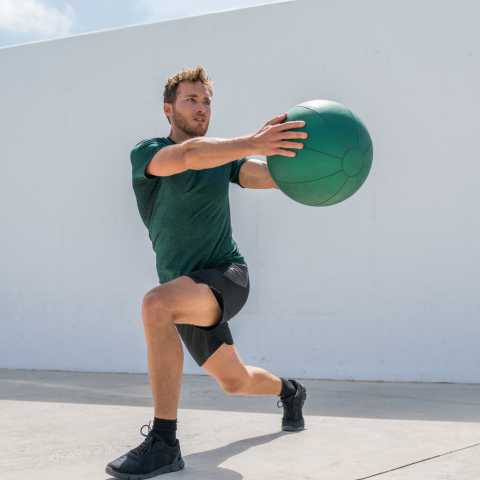
What Are Standing Ab Exercises?
The most common abdominal exercises are those done in a prone position (plank) or supine (hollow body) on the ground. When looking for variations of abdominal exercises, the great news is almost every core exercise can be done standing.
If you're someone recovering from an injury, pregnant, has limited mobility, or is compromised with accessibility of getting down on the ground, you'll have access to the same core benefits in the standing position. With proper alignment, activation, and additional resistance used, the options really are broad.
But before we get into that, we need to understand the anatomy of the core.
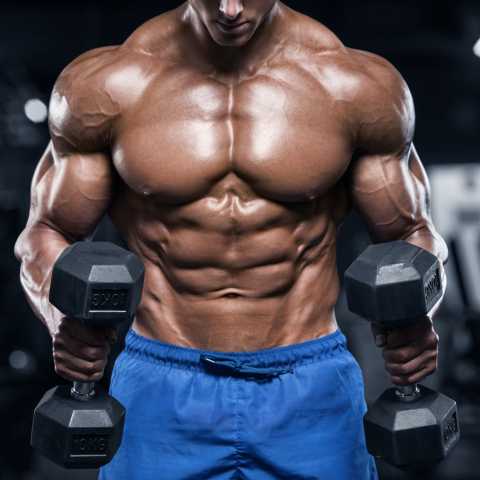
Abdominal Muscle Anatomy
The abdominal muscles are strong bands of muscle that line the walls of your abdomen, running vertically and horizontally between the rib cage and the pelvis.
The major muscles of the abdomen are the rectus abdominis, external obliques, internal obliques and transversus abdominis. These muscles work together to help the body function in several ways, like maintaining consistent internal pressure on the abdomen, maintaining posture, and supporting the spine during rest and movement.
Let's take a further look at each abdominal muscle and its unique functions:
- Rectus Abdominis: Running vertically, from the rib cage to the front of the hips, this muscle holds the internal organs in place and keeps your body stable throughout movement. This muscle is most known for its appearance as the "six-pack." To target the rectus abdominis, incorporate movements that involve spinal flexion, like your classic abdominal "crunch."
- External Obliques: Located on the sides of the rectus abdominis, the external obliques run from the sides of the body and insert towards the midline. The external obliques allow the trunk to twist from side to side. To target this region, rotate from the trunk while stabilizing through the hips with woodchoppers and bicycle crunches.
- Internal Obliques: A pair of muscles that lay deeper than the external obliques inside the hip bones, the internal obliques work with the external obliques to allow the trunk to twist and turn. Fatigue these muscles by exercises that include rotation and stabilization, (also targeting the external obliques) like slow and controlled rotating Pallof presses. You can also check out our article on the Best Oblique Exercises for more ways to target these abdominal muscles!
- Transverse Abdominis: The deepest of the abdominal muscles, the transverse abdominis lays horizontally across the lowest portion of the trunk, similar to a belt. Its primary function is to stabilize and maintain internal abdominal pressure. Work through planks, bird dogs, and any heavy lifting to especially target this muscle.
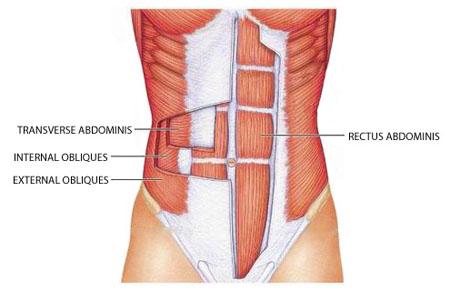
12 Best Standing Core Exercises
Explore the 12 most efficient standing abdominal exercises to hit your entire core below.
1) Standing Bicycle Crunches:
To kick us off, this exercise targets the obliques and the rectus abdominis. In the standing stance, you'll find that the neck has less strain and tension compared to the supine variation. Focus on your balance and ability to rotate fully while keeping abdominal tension with each repetition.
How to do the Standing Bicycle Crunch:
- Stand tall with your feet about shoulder distance apart and your arms bent, hands behind your head.
- As you bring your left leg into a high knee stance, rotate through your core and reach your right elbow to your knee.
- Through your rotational reach, slightly round your back and keep tension in your core.
- Return to standing and switch sides, tucking your left elbow to your right knee.
Watch Standing Bicycle Crunch Demo on YouTube
2) Standing Crossover Toe Touch:
Like the bicycle crunch, the crossover toe touch challenges the obliques, rectus abdominis, and transversus abdominis. This movement combines both a single leg lift, which recruits the transverse abdominis, and a rotational contraction, which engages the obliques.
How to do the Standing Crossover Toe Touch:
- Stand tall with your feet shoulder distance apart and your arms at your sides.
- Keep your left leg straight and lift it to 90 degrees in front of you while rotating and reaching for your toes with your right arm.
- Actively reach toward your opposite foot and feel the stretch. You do not need to physically reach to touch the toes to complete a repetition.
- Switch sides and continue to rotate through the trunk while reaching for the toes.
Watch Standing Crossover Toe Touch Demo on YouTube
3) TRX Hip Drop:
This unilateral exercise effectively trains your posture and recognizes your imbalances, especially through the obliques. It may be intimidating to trust the TRX straps, so take your time adjusting your resistance. The closer your feet are to the anchor point, the more challenging the movement will be.
How to do the TRX Hip Drop:
- Loop both hands through the TRX handles and step away from the anchor point until you feel tension on the straps.
- Send your arms overhead and rotate your body so your right side faces the anchor point.
- Cross your left leg in front of your right.
- Maintaining your arms overhead and your feet crossed, shift your hips to the left side (away from the anchor point).
- Once you feel a deep stretch and activation through the left side of your body, pull against the straps to stack your body back to the start position.
Watch TRX Hip Drop Demo on YouTube
4) Medicine Ball Slam:
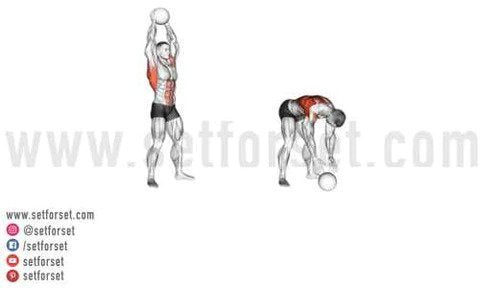
An athletic way to incorporate abdominal work, medicine ball exercises like the slam are an efficient exercise to target speed and power. The rectus abdominis forcefully contracts as the med ball travels from overhead to the ground.
How to do the Medicine Ball Slam:
- Stand tall with a medicine ball in both hands, feet hip width apart.
- Press the medicine ball up and overhead, keeping your elbows slightly bent.
- Brace through your lower body and let your upper body slightly round as you forcefully slam the ball down to the ground.
- Send the tension of the slam to your abdominals with a big exhale.
- Catch the ball, then reset for the next slam.
5) Standing Stabilization:
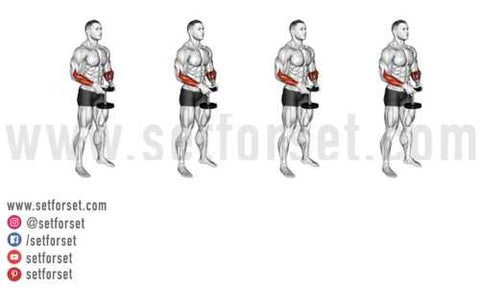
Simply holding a weight out in front of you is a practical way to train for everyday life. Keep your standing structure stable, keep your shoulders packed, and allow your traps to relax. Allow your transversus abdominis to take over the work.
How to do Standing Stabilization:
- With your feet hip distance apart, stand tall and hold a weight with both hands at your chest.
- Extend your arms out in front of you and keep your posture neutral and your abdominals engaged.
- Exhale through your belly as you pause for two counts.
- Pull the weight close to your body and repeat.
6) Woodchop:
Utilizing your entire body to pivot and move resistance is one way to improve athleticism and your ability to maintain proper posture. In that way, the woodchopper targets balance, stability, and coordination. When doing this exercise, make sure to consistently engage your core and focus on rotating through your obliques.
How to do the Woodchop:
- In your standing stance, place your feet slightly wider than hip distance apart and hold one weight in both of your hands.
- Hinge through the hips to rotate to lower the weight across your body, toward your left foot.
- Bend through the knees and pivot your feet toward your left.
- Keep your arms slightly bent at the elbows and send the weight across your body until you extend the weight overhead on your opposite side (right) in one smooth chopping motion.
- Make sure to switch the pivot of your feet towards the right side, following the resistance.
- As you grow more comfortable, complete each chop with a smooth rhythm.
- Complete your designated reps before switching over sides.
Watch Standing Woodchop Demo on YouTube
7) Pallof Press:
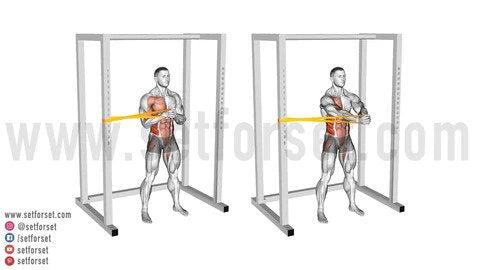
This exercise can be incorporated into any exercise program and is functional for body awareness, activating the transversus abdominis and challenging the obliques as stabilizers. Challenge yourself by standing with your feet closer together (narrow base of support) or loading heavier resistance.
How to do the Pallof Press:
- Using a cable or a band, adjust it to elbow height.
- Interlace both hands in the handle and take a few steps away from the anchor point.
- Turn away from the anchor point so the side of your body is at 90 degrees.
- Press the band straight out in front of you while maintaining posture and engaging through the core.
- Return to the start position and repeat reps. Then repeat on the opposite side.
8) Standing Lateral Bend:
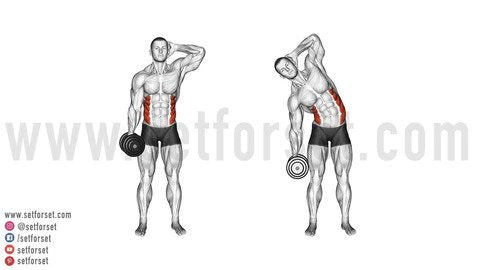
Target your core stabilizers as well as deep obliques with the standing side bend. A key to proper form is ensuring your hips stay under your rib cage at all times, allowing your abdominals to activate and function properly.
How to do the Standing Lateral Bend:
- Stand with your feet shoulder-width apart, hold a weight in one hand, and place your other hand on your hip.
- Bend from your waist laterally and reach your weighted arm alongside your body toward the ground. Keep your arms straight.
- Engage your abdominals to pull you back into a stacked starting position. Repeat reps for one side, and then switch sides and repeat.
9) Kettlebell Around The World:
This exercise is dynamic, and your body is challenged to stabilize in a neutral stance. Transverse abdominis takes on most of the work of stabilizing through the hips. Make sure to slightly bend through the elbows for a more comfortable swing.
How to do the KB Around The World:
- In a neutral standing stance, hold the handle of your kettlebell with your right hand in front of your hips.
- Initiate your swing by moving the kettlebell toward your right side.
- Reach and catch the kettlebell behind you with your left hand, and as the kettlebell completes a revolution, catch it with your right hand in front of your hips.
- Repeat smooth, consistent repetitions moving in this direction while emphasizing your stable posture and active core.
- Slow down the kettlebell and switch sides.
Watch KB Around The World Demo on YouTube
10) Weighted Uppercut:
Have you ever taken a boxing class? If you have, you can relate to how fatigued the core feels after throwing powerful punches!
With a weighted uppercut, focus on emphasizing the rotation from your torso, targeting the obliques, and keeping the weight controlled and close to your body.
How to do the Weighted Uppercut:
- Have one weight (preferably a dumbbell) in your hands and send it to the right side of your body with the arms fully extended at your side.
- Keep your feet and hips neutral and facing forward the whole time.
- Bend through the elbows and pull the weight across your body (like a seatbelt).
- Rotate your torso and uppercut the weight toward the upper left side of your body.
- Keep your elbows bent in the uppercut and the weight at collarbone level.
- Send the weight all the back down to the start position.
Watch Weighted Uppercut Demo on YouTube
11) Lunge With Twist:
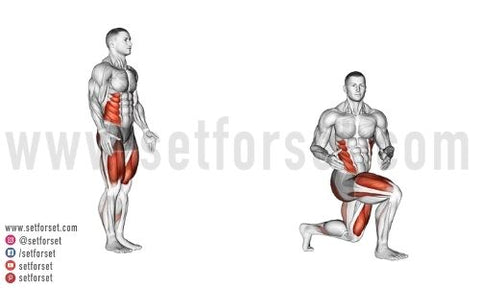
This movement connects the lower body, torso, and upper body to target the abs. You'll definitely feel your obliques start to burn. Once you get comfortable with form, increase your speed, coming up to the twist with a powerful ab activation.
How to do a Lunge With A Twist:
- Start in a reverse lunge position with your left leg forward and right leg back, each bent at 90 degrees.
- Slightly lean your torso forward into your left leg and raise both arms overhead.
- Drive your right leg up into a high knee position and rotate your torso towards your leg.
- Complete a twist by pressing your arms down to reach across the outside of your right leg's high knee.
- Step back into your lunge and reset your arms in the overhead position.
12) Standing Bird Dog:
The bird dog targets your balance, stability, and coordination. Maintain a neutral posture as you shift your weight from side to side. This exercise primarily targets the rectus abdominis and the transverse abdominis. The obliques stabilize and fight any rotation through the hips and torso.
How to do a Standing Bird Dog:
- Stand with feet hip distance apart and your arms at your sides, and drive your left knee toward a high knee stance while reaching your right arm overhead.
- Feel the contraction of your core as you actively move into position.
- Maintain your balance, brace through your core, and slowly lower your leg and arm to switch sides.
Watch Standing Bird Dog Demo on YouTube
Sample Standing Core Workout
Complete one of these at the end of your strength or cardio workout.
Workout A: Rotational Target (Rectus Abdominis, Internal and External Obliques)
|
Exercise |
Sets & Reps |
Duration |
|
Woodchopper Right |
4 sets |
30 seconds each |
|
Standing Alternating Bicycle Crunches |
4 sets |
30 seconds each |
|
Woodchopper Left |
4 sets |
30 seconds each |
|
Standing Crossover Toe Touches |
4 sets |
30 seconds each |
Workout B: Stabilization Target (Rectus Abdominis, Transversus Abdominis)
|
Exercise |
Sets (x) |
Repetitions (R/L) |
|
Kettlebell Around the World R/L |
3 |
10/10 |
|
Lateral Bend |
3 |
12/12 |
|
Pallof Press |
3 |
10/10 |
Benefits Of Standing Ab Exercises
One main reason you would want any muscle, especially the abdominal muscles, to gain strength is to improve your quality of life. Stronger abdominals allow you to live an active life with a lesser chance of injury. You'll have the support needed for stabilizing your spine through changing postures, preventing lower back injuries, and improving performance in daily activities.
Remember, six-pack abs do not equate to strong and functional abdominals. Learn more about the benefits of strong abs below.
1) Improve Balance and Stability:
The trunk is the most central part of the body. It includes the pelvis, lower back, and the abdominals. Abdominal exercises train the muscles in your trunk to work and stabilize as a unit.
This leads to a better understanding of coordination, translating directly to balance and stability throughout movement. Balance and stability are essential because they naturally decline with age if not trained regularly. Everyday movement depends on a balanced and stable body.
2) Breathe Better:
Building a strong core can improve your ability to breathe more efficiently. The diaphragm, the major muscle of respiration, depends on proper posture and position to function optimally.
Improving your core strength can neutralize the hips and stack your body, allowing the diaphragm to function rhythmically. Breathing efficiently improves all forms of movement, running, yoga, HIIT, LISS, strength, and conditioning.
3) Overall Improvement of Strength:
Daily movement and regular exercise begin to feel easier when the core muscles are conditioned and strong. You'll be able to recognize when the core is engaged and how to brace throughout the abdomen.
On the other hand, weak core muscles can lead to fatigue, injuries, and a slow improvement in total body strength. With a weak base of support, the body will start to compensate through poor posture, displacing body weight through the lower back, and an increased risk of muscle injuries.
4) Reach Your Goals:
A fundamental element of any well-rounded fitness program is movements that either include or target the core musculature. Whether that's squatting heavy, practicing rotational movements, and/or completing isolated core exercises, better movement would not be possible without a strong core.
Your ability to keep improving in your fitness program depends on a solid trunk, stabilizing heavier weights, and making sure the proper musculature is active.
5) Protect Your Lower Back:
A strong core is shown to prevent lower back pain by aligning the hips and ribcage and strengthening the trunk as a whole.
With a stronger core, you'll be more mindful of your day-to-day movements. Instead of compensating throughout the lower back, a strong core will ensure that your weight is displaced through the trunk as well as the rest of your body.
6) Tone The Abdominal Muscles:
Just like any muscle, building substantial strength and muscle hypertrophy for that muscle will make it grow and be more prominent on the body. A well-defined six-pack is a combination of growing the abdominals and shedding body fat with fat-burning aerobic activity.

Best Diet Practices To Pair With Standing Ab Exercises
News flash! If you've been working hard for those six-pack abs without tracking or altering your nutrition to align with this goal, you will not see significant results.
A crucial component of developing cut abs is maintaining a low percentage of body fat. You may have heard, "Abs are made in the kitchen," and yes, there is a lot of truth in that! The most superficial layer of your abdomen, rectus abdominis, is the muscle that portrays the ridges and definition of a six-pack. This will be difficult to see unless your body fat is low.
Most people start to see the definition of the abs around 12-15%. However, every person is unique and can start to see definition at higher or lower percentages. A useful statistic to share is that the average American has 28-40% body fat. Your genetics, environment, stress levels, nutrition, and movement routine all significantly affect your body fat percentage numbers.
Every individual holds body fat differently on their bodies, and the journey to six-pack abs will look very different. That doesn't mean that defined abs are not available and possible for everybody. With a proper caloric deficit, it is possible to progressively drop in body fat over time while maintaining muscle. Lower your calories gradually while maintaining nutrient-dense foods in every meal: carbohydrates, proteins, and fats. A food diary is helpful when first making changes to your diet.
A good fact to keep in mind is that a low body fat percentage is more challenging to maintain. Living in a caloric deficit isn't always the most optimal according to your fitness goals. Work with a registered dietician to help determine whether shedding body fat aligns with your body's needs as well as your health and wellness goals.
If your looking for meal plans to help you stay on track, head to our 4 Week Meal Plan For Weight Loss or our High Protein Meal Plan.

Programming Tips For Standing Abs Exercises
The abdominals are just like any other muscle and require the same rest as the rest of your muscles. The abdominals tend to recover faster than other muscles, and it can generally take up to 24-48 hours for full muscle recovery. If your abs are sore, continue to rest, stretch and hydrate.
Core exercises can be programmed 3-5 days per week with up to 5 exercises per session. Depending on the goal of your workout and exercise routine, core exercises can be incorporated with any split: full body, upper only, lower only, cardio training, etc.
Each exercise can be repeated for higher repetition ranges like 10-30 reps or for time, 15 seconds-2 minutes. Since it takes a lot to fatigue the core, higher volume is usually recommended. If you are just starting to incorporate isolated ab exercises into your routine, start with lower-volume work and slowly work your way up.
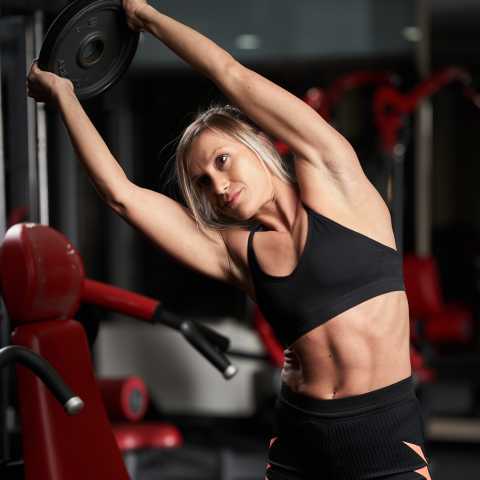
FAQs About Standing Ab Exercises
Let's look at some more of your questions about standing ab exercises and building a toned core.
Does holding in your stomach help burn fat?
While holding in your stomach can help engage the core temporarily, it's not going to contribute to belly fat burn in the long term.
What burns belly fat at night?
Strength training during the day builds lean muscle, and the more lean muscle you have, the more total body fat you can burn at rest. Outside of a consistent strength training plan, some of the best ways to burn belly fat at night include avoiding alcohol, getting a good night's rest, and including some pre-sleep supplements. For more on this, read 7 Easy Ways to Burn Fat While You Sleep.
Should you do cardio or weights first to lose belly fat?
Weight training is a must for burning belly fat. Combined with a well-structured diet, strength training will put on the lean muscle needed to burn fat and put you in a caloric deficit throughout the day. Cardio can help burn extra calories during your workout, but unless you're training 3+ hours each day, it's unlikely to have as significant an effect as weight training.
How many calories does a 10 minute standing ab workout burn?
Total calories burned varies widely across gender, muscle mass, fitness level, and effort put into the workout. If your goal is visible abs, you're better off focusing on getting into a calorie deficit through your diet rather than how many calories you can burn in an ab workout.
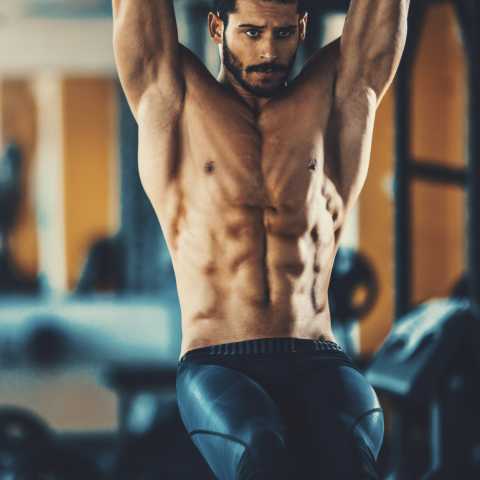
Standing Ab Workouts: Key Takeaways
Building a strong and functional body requires you to prioritize your abdominal muscles. Isolating your core in your fitness routine can improve your quality of life and help you reach your fitness goals more efficiently.
Incorporating standing ab exercises can add to all the benefits that a strong core provides for your body. So what are you waiting for? Go build a strong core!
For more ways to sculpt your stomach, check out the 9 Best Upper Ab Exercises, the 11 Best Lower Ab Exercises, and the 17 Best Cable Ab & Oblique Exercises.

Prepare to maximize your gains with our exclusive 12-week hypertrophy training program. Choose between a 4 or 5 day training split and gain 2-12 pounds of muscle over 90 days...

Also in Blog
Recent Articles
-
Calories In, Calories Out Myth: Fact or Fiction?April 08, 2025
-
Cardio Or Strength Training: What's Better For Weight Loss?April 03, 2025
Must Reads
-
Mr Olympia 2024: What to Expect This Year (Oct. 10-13, 2024)September 11, 2024
-
What Can Walking For 1 Hour Everyday Do For You? My ExperienceFebruary 28, 2024
-
The Ultimate "Bro Split" Workout Plan (Backed By Science)August 05, 2023
- Blog
- Exercises
- Workouts
- Meal Plans
- SFS Programs
- Apparel
- About Us
- FAQ
- Shipping
- Warranty
- Contact Us
- Terms & Conditions
- Privacy Policy
- Affiliates
- SFS UGC Policy
- SFS MBG Policy
- Disclosures
- Legal Disclaimer
Sign up to get the latest on sales, new releases and more…
© 2025
SET FOR SET.
Powered by Shopify
















Paulina Kairys
Author